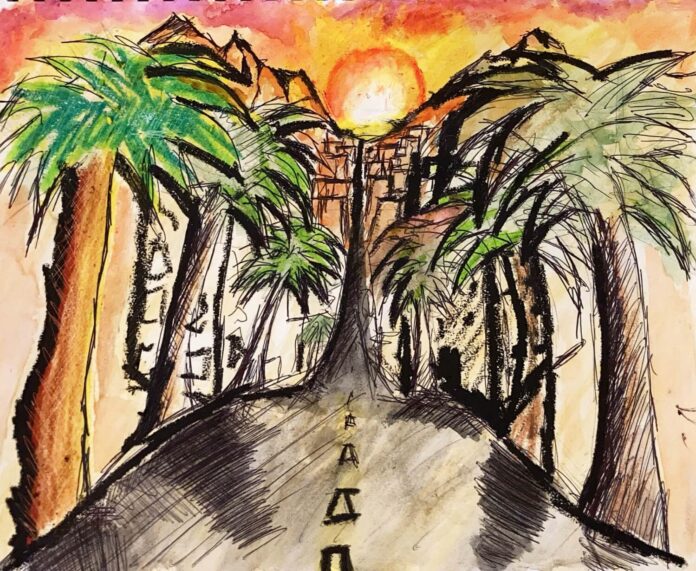There we were, me and six of my fellow Oxy first-year compatriots, standing on the side of Mulholland Drive as the hazard lights of our Honda HR-V rental Zipcar blinked in our stunned faces. We had just hit a flat on the most treacherous stretch of road on Mulholland in the dead of night without insurance or any hope of rescue.
As we stood, formulating plots to get ourselves out of this pinch, I reflected on how we got into this situation. To celebrate a successful first week in college, we decided to go to the beach and explore LA. We got lunch at In-N-Out, walked along Santa Monica Beach, then Santa Monica Pier. On our way back, I had the idea to get tacos at a taco truck and drive up the renowned Mulholland Drive.
I heard about the famed views and cultural significance of Mulholland in books, movies, TV shows, music — practically any form of media I consumed — and my dad, a proud Angeleno, had often extolled in me the virtue of knowing the roads of LA. The 10, the 5, the 405, the 110, the PCH — these broad highways were lionized in my mind as both the sacred boundaries of enclaves and the crucial connectors between communities. Sunset Boulevard, Crenshaw Boulevard, Rodeo Drive, Melrose Avenue, Wilshire Boulevard — these streets were the names and landmarks that guided not only my dad’s story in LA, but also thousands of others reproduced for Hollywood. And Mulholland Drive was chief among them as the hallowed overseer of Tinseltown.
But the jarring reality of our flat tire juxtaposed against this romanticized picture of the City of Angels led me to wonder: Where does this romanticization of streets and highways come from? Why do these strips of concrete and asphalt in Los Angeles play such an important role in the psyches of not just the Angeleno but of the common American?
When my mother immigrated to LA from Seoul in her 30s, she faced a similar kind of disillusionment. Her picture of LA before immigrating was one of paradise, a picturesque city of beauty and opportunity. A town nicknamed the City of Angels had to merit some semblance of heaven on earth. But when she arrived, she was disappointed to find the streets dirty and crowded. LA seemed no different from every other American city that sprawled with littered sidewalks and roads filled with cracks and potholes.
Perhaps a logical answer to my question would lie in the notorious LA traffic. Maybe the streets and highways have essentially forced the people of Los Angeles into appreciation through congestion. My mom had never gotten used to the traffic, and maybe she had not been subjugated by the roads long enough to be deceived into romanticization.
But I think there’s a deeper truth. Other cities have traffic, too, but why has LA in particular romanticized its roads? And why have those outside of the city also accepted this idealized image? Most importantly, why has this romanticization endured throughout generations?
Los Angeles, romanticized or not, is a city of opportunity for millions of dreamers. From people like my grandfather on my dad’s side, who immigrated from South Korea in search of a better life for his family, to the starry-eyed artists, actors and actresses who continually aspire to be the next big thing, LA presents the allure of opportunity indiscriminately to those willing to dream big and chase those dreams.
And there’s a part of me, as I’m sure exists within all Oxy students who have flown, driven or moved out of their hometown to live in the City of Angels, that buys into this allure. Motivated by the desire to be on the up-and-up, in motion, we are all in constant chase of our dreams, praying to the city lights of Los Angeles, hoping to get to the place where we want to be.
This is where our romanticization of streets and highways stems from. The roads not only shape our experiences, but tease us with the feeling that we are just an exit away from our wildest dreams; that we are in transit to a destination we have only seen in the fantasies of our mind. They give us a transitory thrill, if you will, universal to anyone chasing their dreams.
Thankfully, my friends and I were able to put our heads together and figure out how to change the flat. Through some fiddling with lugnuts, a jack and an instruction manual, our rental car was preserved, and we could enjoy the view from Mulholland in peace.
Sometimes, you need to pull over and face the reality of a flat tire. But I think there’s a place in all of our hearts to sit down along the shoulder of Mulholland Drive under an indigo night sky of smog, city lights and stars, and romanticize the roads that’ll take you where you want to be.
![]()



































